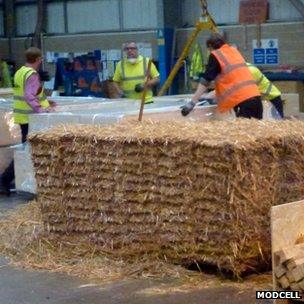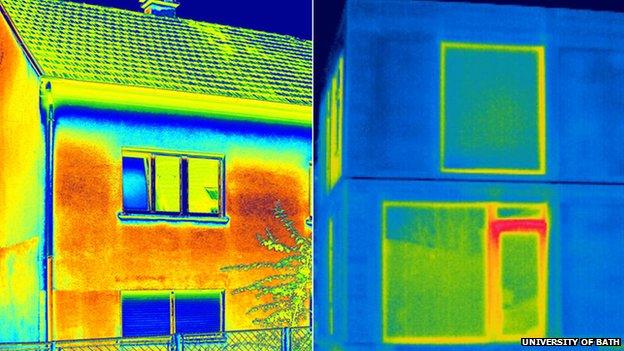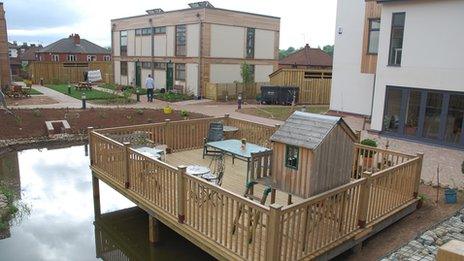Hey, fancy buying a straw house?
- Published
Craig White shows BBC reporter Victoria Gill around one of the new affordable homes made from straw bales
The first straw houses in the UK to be offered on the open market are on sale.
Though straw walls might be most readily linked to a story of pigs making questionable construction choices, the team behind these homes says the material could help to sustainably meet housing demand.
The homes are the result of an engineering research project led by the University of Bath.
The researchers worked with specialist architectural firm Modcell.
The team says this development should move building with straw from a niche technique for the ecologically minded to the wider market.

A typical three-bedroom house would use about seven tonnes of straw
The houses, on a street of traditional brick-built homes in Bristol, are clad in brick to fit in with the surroundings. But their prefabricated walls are timber framed, filled with straw bales and encased in wooden boards.
Prof Pete Walker from the University of Bath, who led the project to develop and test this construction method, told BBC News: "I think there's a lot of misconception about using straw - stories about the three little pigs and the big bad wolf, concerns about fire resistance."
As part of this EU-funded project, Prof Walker and his colleagues have systematically tested and refined the technology - including testing its structural and weight-bearing properties, and its thermal insulation.
"Our testing over a number of years, and our research has demonstrated that it is a robust and safe form of construction."
He added that, since straw absorbs carbon dioxide as is grows, using it as a building material actually "locks carbon into the walls" of a building.

Building with straw - the figures
Straw is the leftover stalks from cereal crops - normally used for animal bedding
Just under four million tonnes of this leftover straw is produced every year by UK agriculture, according to the Agricultural and Horticultural Development Board
It takes about seven tonnes of straw to build a three-bedroom house with this pre-fabrication method
That means there is potential to grow the material for more than half a million new homes every year in British fields.

"They're also a very efficient insulator, so they should reduce energy bills by as much as 90% compared to other houses around this site," Prof Walker added.

Thermal images show how traditional brick house walls (left) lose more heat than a straw bale building
Although these are not the first homes in the UK to be built using straw bales, they are the first to be built for any buyer on the open market.
Craig White, director of Modcell, the design firm involved in the project, explained: "Previously, you'd have a client in place, they knew they wanted a straw bale construction, and they would commission us to deliver that.
"These are the first ones being built speculatively, for the open market," he told the BBC.
"I think it's a very exciting time for this building technology.
"And the more we can build out of renewable materials like straw and timber, the less carbon will be in the atmosphere, so we can reduce climate change effects."
- Published24 October 2013

- Published24 May 2013
